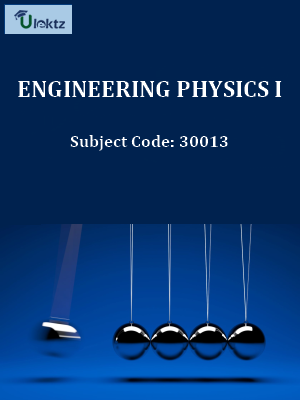

Note: Please check your Spam or Junk folder, in case you didn't receive the email with verification code.
1.1 Units and Measurements - Dimensional formula for length, mass and time, Uses of Dimensional formula, Conventions followed in SI –Units Multiples & sub-multiples and prefixes of units
1.2 Statics - Scalar and vector quantities – Definitions and examples –Concurrent forces and coplanar forces–Definition,Resolution of a vector into two perpendicular components -Resultant and equilibrant–Definitions, Parallelogram law of forces - statement -Expressions for magnitude and direction of the resultant of two forces acting at a point with an acute angle between them, Lami’s theorem - Statement and explanation - Experimental verification of parallelogram law of forces and Lami’s theore
1.3 Moment of a force-Clockwise and anti-clockwise moments - Principle of moments, Couple–Torque acting due to a Couple, Experimental determination of mass of the given body using principle of moments
2.1 Elasticity - Elastic and plastic bodies - Stress, strain Definitions, Hooke’s law - Three types of strain–Elastic and plastic limit, Young’s modulus, Bulk-modulus, Rigidity modulus and Poisson’s ratio–Definitions, Uniform and non-uniform bending of beams, Experimental determination of the Young’s modulus of the material of a beam by uniform bending method
2.2 Viscosity - Coefficient of viscosity-Definition, SIunit and dimensional formula, Stream line flow, turbulent flow-Explanation, Critical velocity–Definition, Reynolds number, Experimental comparison of coefficient of viscosity of two low viscous liquids, Terminal velocity–Definition, Experimental determination of coefficient of viscosity of a highly viscous liquid by Stokes method, Practical applications of viscosity
2.3 Surface Tension- Surface tension & angle of contact-Definitions, Expression for surface tension of a liquid by capillary rise method, Experimental determination of surface tension of water by capillary rise method, Practical applications of capillarity
3.1 Straightline Motion - Introduction- Newton’s Laws of motion, Fundamental Equations of motion for objects -horizontal motion-falling freely-thrown vertically upwards
3.2 Projectile Motion - Projectile motion, angle of projection, trajectory, maximum height, time of flight, and horizontal range–Definitions
3.3 Circular Motion- Relation between linear velocity and angular velocity, Normal acceleration, centripetal force and centrifugal force, Expressions for normal acceleration and centripetal force, Banking of curved paths – Angle of banking, Expression for the angle of banking of a curved path. { tanθ = v2 / (r g) }, Simple harmonic motion
4.1 Rotational Motion of Rigid Bodies- Rigid body–Definition, Moment of inertia of a particle about an axis, moment of inertia of a rigid body about an axis–expressions, Radius of gyration–Definition, Expression for the kinetic energy of a rotating rigid body about an axis, Angular momentum–Definition, Expression for the angular momentum of a rotating rigid body about an axis, Law of conservation of angular momentum–Examples
4.2 Gravitation - Newton’s laws of gravitation, Acceleration due to gravity on the surface of earth, Expression for variation of acceleration due to gravity with altitude(height)
4.3 Satellites - Natural and artificial satellites, Escape velocity and orbital velocity–Definitions, Expression for escape velocity, Expression for orbital velocity, Uses of artificial satellites
5.1 Sound - Wave motion–Introduction and definition–Audiable range Infrasonic-Ultrasonics, Progressive waves, longitudinal and transverse waves–Examples- Amplitude, wave length, period and frequency of a wave–Definitions-Relation between wave length, frequency and velocity of a wave, Stationary or standing waves
5.2 Vibrations-Free & forced vibrations and resonance–definitions and examples - Laws of transverse vibrations of a stretched string
5.3 Sonometer–Experimental determination of frequency of a tuning fork
5.4 Acoustics of buildings–Echo-Reverberation, reverberation time, Sabine’s formula for reverberation time (no derivation)- Coefficient of absorption of sound energy, Noise pollution
5.5 Magnetism - Pole strength –Definitions–Magnetic moment, intensity of magnetisation, magnetising field intensity, magnetic induction, permeability, Hysteresis, saturation, retentivity and coercivity – Definitions, Method of drawing hysteresis loop of a specimen using a solenoid, Uses of Hysteresis loops
 No Preview is available for this book
No Preview is available for this book

 Get 100 instant uPoints on the purchase of Rs.100 or above for each order.
Get 100 instant uPoints on the purchase of Rs.100 or above for each order.
CategoriesEngineering Physics

Format EPUB

TypeeBook